Related Research Articles

Gonzalo Jiménez de Quesada y Rivera, also spelled as Ximénez and De Quezada, was a Spanish explorer and conquistador in northern South America, territories currently known as Colombia. He explored the territory named by him, New Kingdom of Granada, and founded its capital, Santafé de Bogotá. As a well-educated lawyer he was one of the intellectuals of the Spanish conquest. He was an effective organizer and leader, designed the first legislation for the government of the area, and was its historian. He was governor of Cartagena between 1556 and 1557, and after 1569 he undertook explorations toward the east, searching for the elusive El Dorado. The campaign didn't succeed and Jiménez then returned to New Granada in 1573. He has been suggested as a possible model for Cervantes' Don Quixote.
Judy Lynn Genshaft was President of University of South Florida from 2000 to 2019. She stepped down from the position in July 2019 after a 19-year tenure.

The University of South Florida (USF) is a public research university with its main campus located in Tampa, Florida, United States, and other campuses in St. Petersburg and Sarasota. It is one of 12 members of the State University System of Florida. USF is home to 14 colleges, offering more than 240 undergraduate, graduate, specialist, and doctoral-level degree programs. USF is classified among "R1: Doctoral Universities – Very high research activity" and is accredited by the Commission on Colleges of the Southern Association of Colleges and Schools. USF is a member of the Association of American Universities (AAU) and is designated by the Florida Board of Governors as one of three Preeminent State Research Universities.
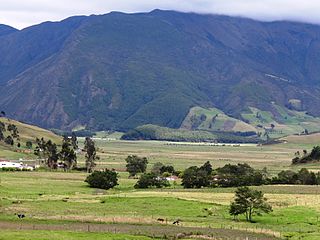
The Altiplano Cundiboyacense is a high plateau located in the Eastern Cordillera of the Colombian Andes covering parts of the departments of Cundinamarca and Boyacá. The altiplano corresponds to the ancient territory of the Muisca. The Altiplano Cundiboyacense comprises three distinctive flat regions; the Bogotá savanna, the valleys of Ubaté and Chiquinquirá, and the valleys of Duitama and Sogamoso. The average altitude of the altiplano is about 2,600 metres (8,500 ft) above sea level but ranges from roughly 2,500 metres (8,200 ft) to 4,000 metres (13,000 ft).

Beginning in the second half of the 16th century, the Kingdom of Spain established missions in Spanish Florida in order to convert the indigenous tribes to Roman Catholicism, to facilitate control of the area, and to obstruct regional colonization by Protestants, particularly, those from England and France. Spanish Florida originally included much of what is now the Southeastern United States, although Spain never exercised long-term effective control over more than the northern part of what is now the State of Florida from present-day St. Augustine to the area around Tallahassee, southeastern Georgia, and some coastal settlements, such as Pensacola, Florida. A few short-lived missions were established in other locations, including Mission Santa Elena in present-day South Carolina, around the Florida peninsula, and in the interior of Georgia and Alabama.
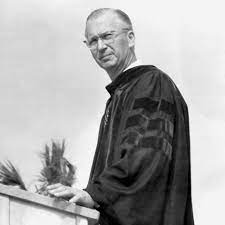
John Stuart Allen was an American astronomer, university professor and university president. He was a native of Indiana, and pursued a career as a professor of astronomy after receiving his bachelor's, master's and doctorate degrees. In 1953 Allen became the interim president of the University of Florida located in Gainesville, Florida, and subsequently became the founding president of the University of South Florida in Tampa, Florida.
Gonzalo Méndez de Canço y Donlebún was a Spanish admiral who served as the seventh governor of the Spanish province of La Florida (1596–1603). He fought in the Battle of San Juan (1595) against the English admiral Francis Drake. During his tenure as governor of Florida, he dealt severely with a rebellion known as Juanillo's revolt among the Native Americans in Guale, forcing them, as well as other tribes in Florida, to submit to Spanish domination. De Canço was best known, however, for promoting the cultivation of maize in the province, and for introducing its cultivation to Asturias, Spain, where it eventually became an important crop.
Pedro de Ibarra was a Spanish general who served as a Royal Governor of Spanish Florida.
Juan Menéndez Márquez y Valdés (1531–1627) was royal treasurer and interim governor of Spanish Florida, and governor of Popayán Province. He was the father of Francisco Menéndez Márquez, who succeeded him as governor of Florida (1646–1648).
Bartolomé de Argüelles was the lieutenant treasurer, royal accountant and co-interim governor of La Florida (1595–1597) with Alonso de las Alas and Juan Menéndez Márquez. He served as lieutenant treasurer during the administration of governor Pedro Menéndez de Márquez (1577-1594).
Juanillo was a chief of the Native American Tolomato people in the Guale chiefdom, in what is now the US state of Georgia. In September 1597, Juanillo led the so-called Gualean Revolt, or Juanillo's Revolt, against the cultural oppression of the indigenous population in Florida by the Spanish authorities and the Franciscan missionaries. This was the first and longest-lasting Guale rebellion in La Florida, and ended with the execution of Juanillo by a group of Native American allies of the Spanish, led by Chief Asao.
Nuestra Señora de Guadalupe de Tolomato was a Spanish Catholic mission founded in 1595 in what is now the state of Georgia, located north of the lands of the southernmost Native American Guale chiefdom, Asao-Talaxe.
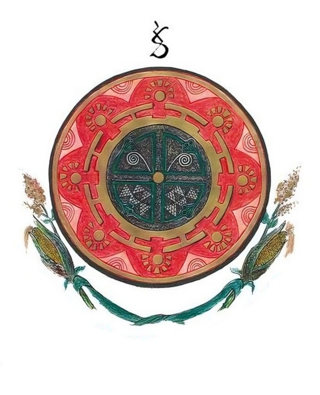
The Muisca Confederation was a loose confederation of different Muisca rulers in the central Andean highlands of what is today Colombia before the Spanish conquest of northern South America. The area, presently called Altiplano Cundiboyacense, comprised the current departments of Boyacá, Cundinamarca and minor parts of Santander.
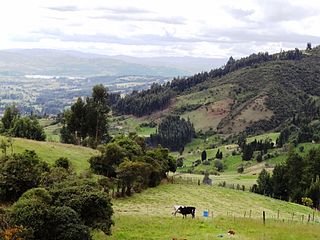
Tundama or Saymoso was a cacique of the Muisca Confederation, a loose confederation of different rulers of the Muisca who inhabited the central highlands of the Colombian Andes. The city of Tundama, currently known as Duitama and part of the Tundama Province, Boyacá, were named after the cacique. Tundama ruled over the northernmost territories of the Muisca, submitted last by the Spanish conquistadores.

The Panche or Tolima are an indigenous group of people that lived in what is now Colombia. They inhabited the southwestern parts of the department of Cundinamarca and the northeastern areas of the department of Tolima, close to the Magdalena River. At the time of the Spanish conquest, more than 30,000 Panche were living in what would become the New Kingdom of Granada. Early knowledge about the Panche has been compiled by scholar Pedro Simón.
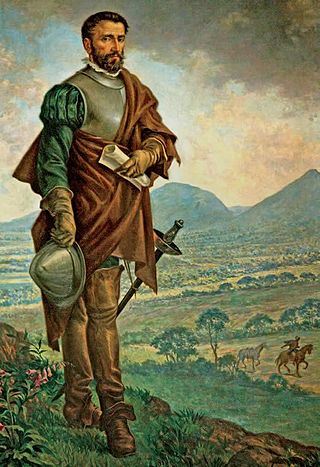
The Spanish conquest of the Muisca took place from 1537 to 1540. The Muisca were the inhabitants of the central Andean highlands of Colombia before the arrival of the Spanish conquistadors. They were organised in a loose confederation of different rulers; the psihipqua of Muyquytá, with his headquarters in Funza, the hoa of Hunza, the iraca of the sacred City of the Sun Sugamuxi, the Tundama of Tundama, and several other independent caciques. The most important rulers at the time of the conquest were psihipqua Tisquesusa, hoa Eucaneme, iraca Sugamuxi and Tundama in the northernmost portion of their territories. The Muisca were organised in small communities of circular enclosures, with a central square where the bohío of the cacique was located. They were called "Salt People" because of their extraction of salt in various locations throughout their territories, mainly in Zipaquirá, Nemocón, and Tausa. For the main part self-sufficient in their well-organised economy, the Muisca traded with the European conquistadors valuable products as gold, tumbaga, and emeralds with their neighbouring indigenous groups. In the Tenza Valley, to the east of the Altiplano Cundiboyacense where the majority of the Muisca lived, they extracted emeralds in Chivor and Somondoco. The economy of the Muisca was rooted in their agriculture with main products maize, yuca, potatoes, and various other cultivations elaborated on elevated fields. Agriculture had started around 3000 BCE on the Altiplano, following the preceramic Herrera Period and a long epoch of hunter-gatherers since the late Pleistocene. The earliest archaeological evidence of inhabitation in Colombia, and one of the oldest in South America, has been found in El Abra, dating to around 12,500 years BP.
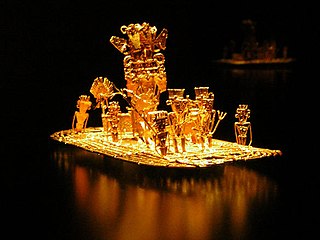
This article describes the warfare of the Muisca. The Muisca inhabited the Tenza and Ubaque valleys and the Altiplano Cundiboyacense, the high plateau of the Colombian Eastern Ranges of the Andes in the time before the Spanish conquest. Their society was mainly egalitarian with little difference between the elite class (caciques) and the general people. The Muisca economy was based on agriculture and trading raw materials like cotton, coca, feathers, sea snails and gold with their neighbours. Called "Salt People", they extracted salt from brines in Zipaquirá, Nemocón and Tausa to use for their cuisine and as trading material.

The Georgia Martyrs are five Spanish Friars Minor murdered in September 1597 "in hatred of the faith" while conducting missionary work in Spanish Florida. Their particular mission took place in what is now the State of Georgia. As of January 2025, they have been formally declared martyrs by the Catholic Church and are set to be beatified.
References
- ↑ "Can one man overcome 500 years of distorted Florida history?". Tampa Bay Times. 4 March 2013. Retrieved 29 January 2025.
Francis, 45, is a blond-haired, blue-eyed, baby-faced historian at the University of South Florida St. Petersburg...
- ↑ Becnel, Thomas (27 March 2013). "Ponce de Leon's Florida fountain search is a pack of lies?". Sarasota Herald-Tribune. Retrieved 29 January 2025.
Francis, 45, is a blonde and blue-eyed history professor who has become the handsome face of Spanish colonial scholarship in Florida. ... Francis is a Canadian from Alberta...
- 1 2 "J. Michael Francis". University of South Florida. Retrieved 26 January 2025.
- 1 2 "J. Michael Francis, Ph.D." University of South Florida College of Arts and Sciences. Retrieved 26 January 2025.
- ↑ "Governor appoints professor to Florida Historical Commission". University of South Florida. 22 September 2021. Retrieved 26 January 2025.
- ↑ "USF History professor inducted into Spanish royal order for groundbreaking work on Florida's early history". University of South Florida. 26 October 2021. Retrieved 26 January 2025.
- ↑ Kumar, Divya (28 October 2021). "USF professor honored by the King of Spain for work on Florida's history". Tampa Bay Times. Retrieved 26 January 2025.
- ↑ "Presentation of La Florida: The Interactive Digital Archive of the Americas". Cultural Office of the Embassy of Spain, Washington, D.C. March 2018. Retrieved 29 January 2025.
- ↑ Cimitile, Matthew (18 July 2024). "Innovative digital archive project receives Florida historic preservation award". University of South Florida. Retrieved 29 January 2025.
- ↑ Bancroft, Colette (14 October 2015). "Festival of Reading: Florida's history flows through four festival books". Tampa Bay Times. Retrieved 27 January 2025.
- ↑ Reviews of Murder and Martyrdom in Spanish Florida include:
- Dubcovsky, Alejandra (2013). "Murder and Martyrdom in Spanish Florida: Don Juan and the Guale Uprising of 1597". Colonial Latin American Review. 22 (3): 452–453. doi:10.1080/10609164.2013.851356.
- Wickman, Patricia Riles (May 2013). "Murder and Martyrdom in Spanish Florida: Don Juan and the Guale Uprising of 1597". The Journal of Southern History. 79 (2445–446): 445–446. ProQuest 1353069873.
- ↑ Reviews of Invading Colombia include:
- Offutt, Leslie S. (2009). "Rereading Conquest: Recent Works on the Conquests of Mexico, Guatemala, and Colombia". Ethnohistory. 56 (1): 187–193. doi:10.1215/00141801-2008-040.
- Altman, Ida (July 2008). "Invading Colombia: Spanish Accounts of the Gonzalo Jiménez de Quesada Expedition of Conquest (review)". The Journal of Military History. 72 (3): 935–936. doi:10.1353/jmh.0.0058.